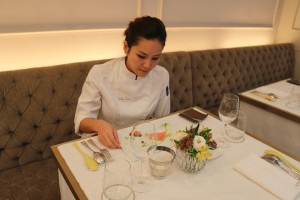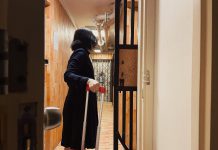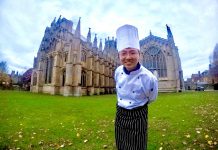Lau did not stop there. She felt she still had much to learn about cooking and in particular she was interested to learn about fine dining in Hong Kong. Armed with her diploma, she landed a job in the kitchen at the Michelin-starred French restaurant Cépage.
According to Chef Sébastien Lepinoy, in 2011, when he was head chef at Cépage, Lau arrived with the CV of a designer but he was curious to see what Lau could bring to the restaurant.
She started as commis chef, where she rotated through different stations for a better understanding of how the kitchen worked. She worked 15 hours a day, and did all kinds of jobs ranging from mopping the floor and cleaning the freezers to preparing ingredients. The process was tiring, but Lau knew it was necessary for her to start from the basics.
After a few weeks, Lepinoy already knew Lau had great potential to become a professional chef. “Vicky was one of my best students,” he says. “She is very motivated and always wants to learn, always interested to talk about cuisine.”
Lau says what she learned most from her stint at Cépage was the importance of teamwork. Designing is a one-person job, but in the kitchen, “you have to rely on each other to make things happen.”
After a year of intense learning at Cépage, Lau made a bold move by striking out on her own on a project that would incorporate both her design sensibilities and appreciation for culinary arts.

The preparation process was rather painful. She did all the work alone, spending hours and hours looking for a venue, food suppliers and staff, and worked around the clock to figure out the application process for food business licenses. The planning and searching took half a year, and in the last few weeks before Tate’s opening, Lau only managed around three hours of sleep a day.
Her efforts paid off. Tate turned out to be a cozy dining room with around 30 seats and an open kitchen. It is easy for her to walk around and talk to diners. Lau has a staff of eight and to ensure the quality of the food, they only serve dinner.
Lau believes food reflects culture. The dishes at Tate are a mixture of French and Japanese cuisine. Lau says this cooking style reflects her own experiences while growing up.
As a child, Lau used to live with her grandfather, who came from Chaozhou in eastern Guangdong, so she enjoyed Chaozhou cooking at home. Chaozhou cuisine focuses on keeping the natural tastes of the ingredients. Japanese cuisine influences Lau’s cooking style in terms of her wish to keep everything simple and authentic.
During her college years in New York, Lau got the chance to explore that city’s dynamic dining scene. “It’s a melting pot in New York. You get to meet a lot of people from different cultural backgrounds, you get all these ingredients from all over the world, so it’s natural that you would like to experiment with that,” she says.






































